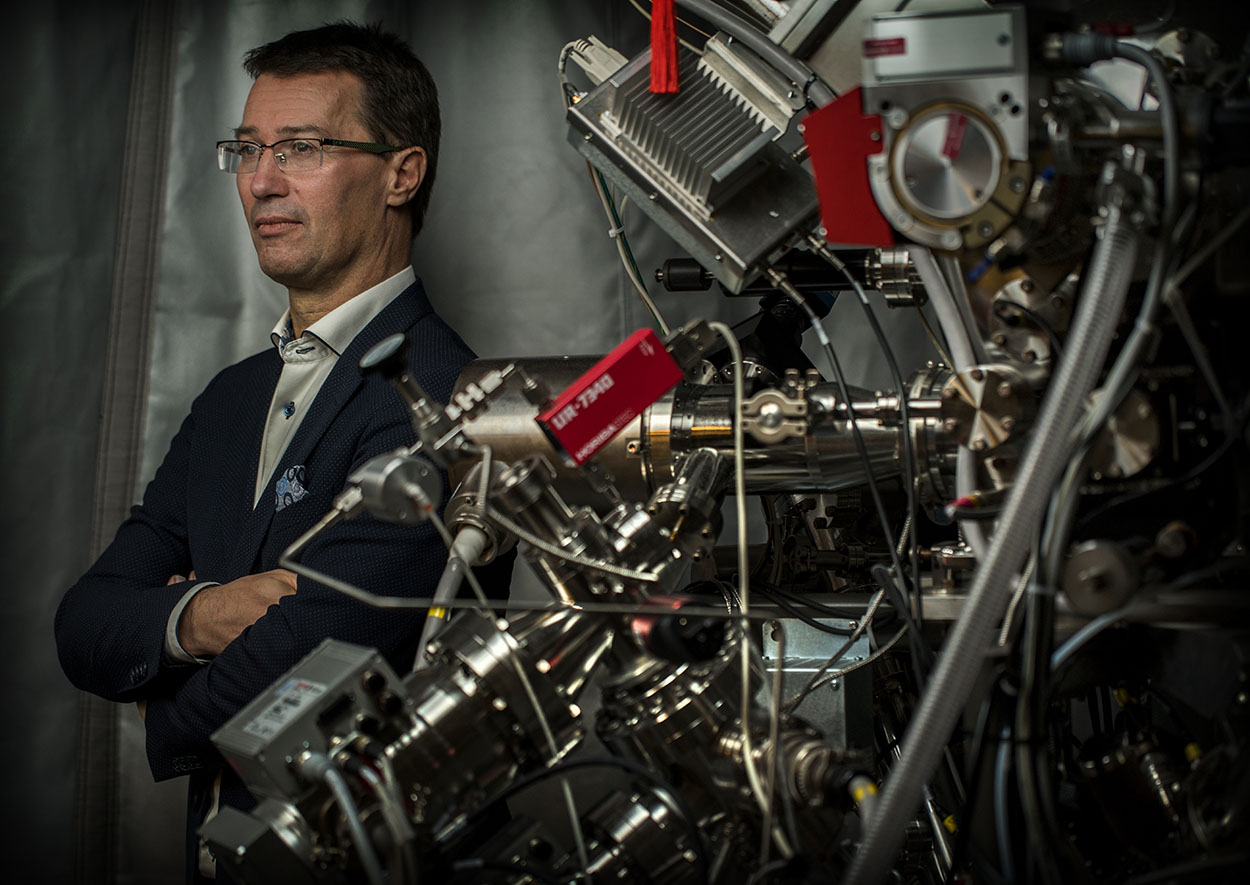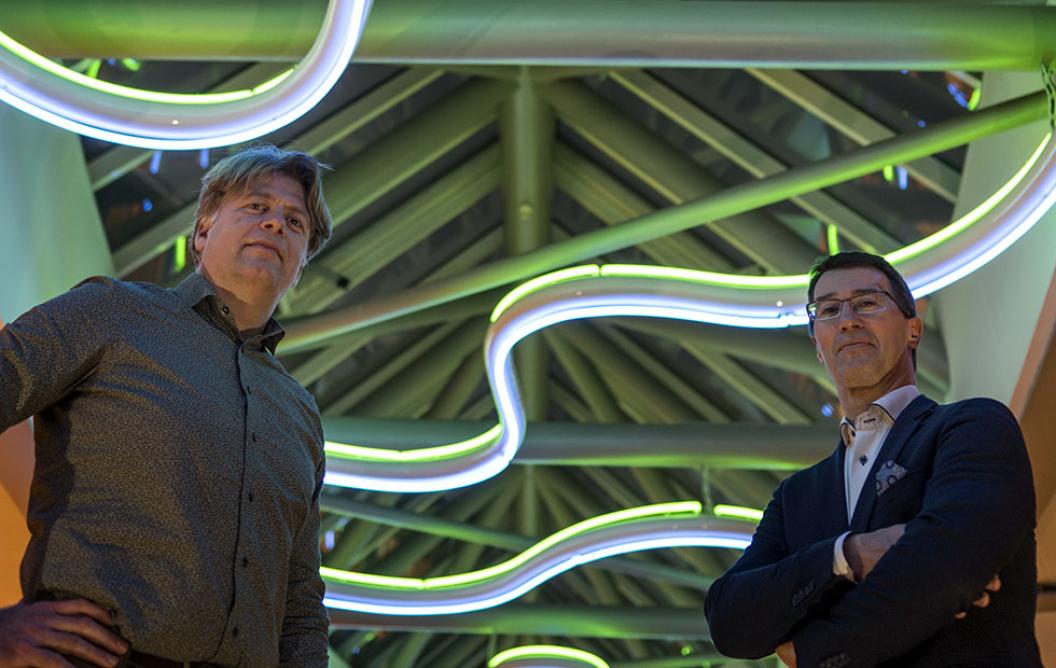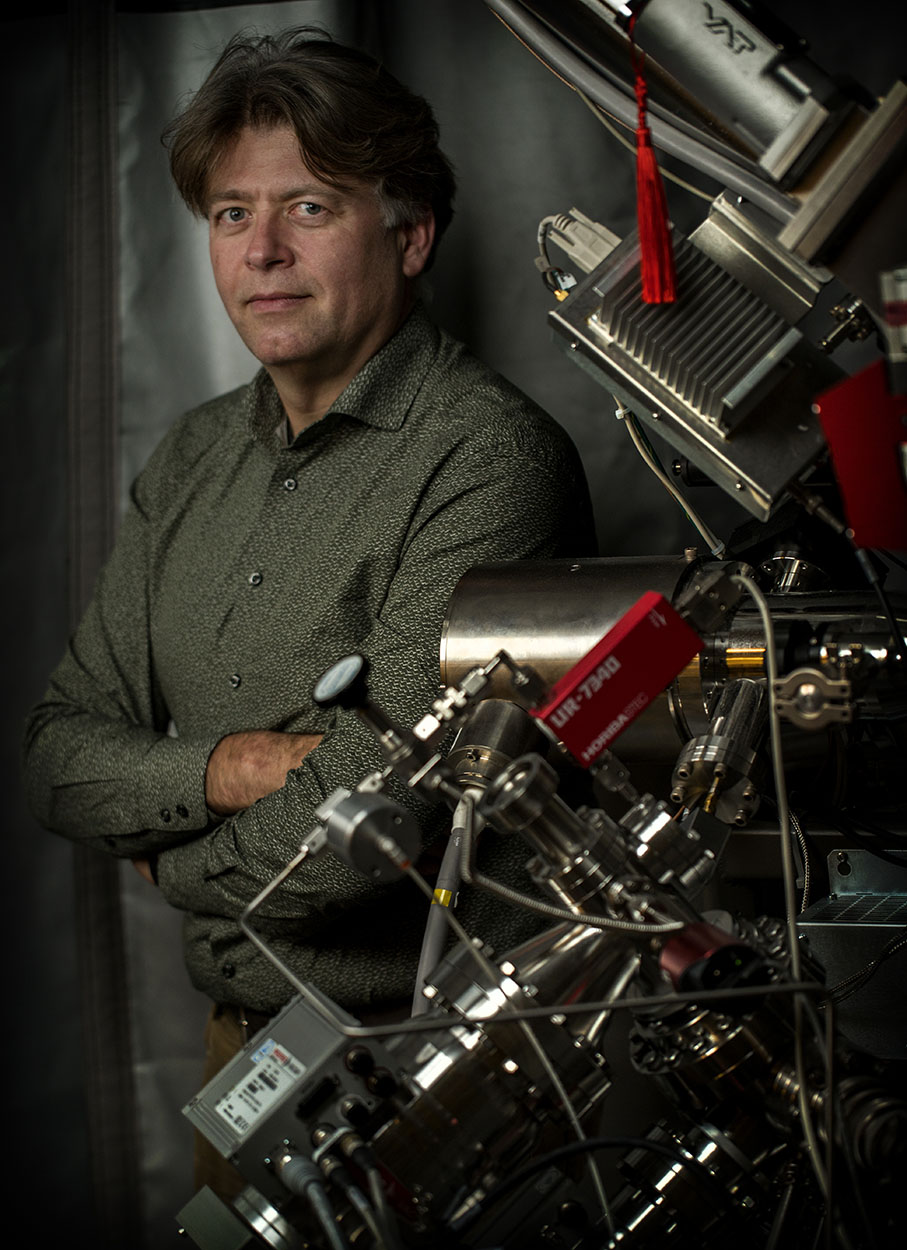From instrumentation physicist to socially engaged scientist
Gerard van Rooij, professor of Plasma Chemistry, was the first PhD candidate of Ron Heeren, university professor and director of the M4I institute. Together they reflect on a pioneering period in which they took the first tentative steps in the development of imaging mass spectrometry. Heeren: “From Gerard I learnt to put myself as a supervisor to one side.” Van Rooij: “I find it impressive how Ron wants to change research field every ten years. I’ve now managed that too.”
There is something incongruous about interviewing two professors, both around the same age, for an article featuring a professor and his student. That’s certainly not how they experienced their relationship. Van Rooij: “We’ve gone through pretty much all phases of collaboration together, starting from when we were students at the AMOLF institute for fundamental physics in Amsterdam.” Heeren: “At some point I became Gerard’s supervisor; he was my first PhD student. But we did almost everything together: experimenting, coming up with ideas. I’d sooner call it a friendship.”
“Of course, we sometimes had conflicting interests. The donkey doesn’t want to walk, and the master is pushing and pulling,” Van Rooij laughs. “You have that in every relationship. Now that I supervise PhD students myself, I also see it from the other side. Doctoral research is not something where you can just say: you figure it out. You have a common goal and together you spend four years working towards it. I try to coach my PhD students in their development, rather than having some distant supply-and-demand relationship.”

Ron Heeren obtained his PhD in 1992 for his research on plasma-surface interactions at the University of Amsterdam. In 1999 he established a research group focusing on the development of imaging mass spectrometry. He was appointed university professor and Limburg Chair in the field of molecular imaging with an interfaculty research programme at Maastricht University (UM) in 2014. He is also director of the Maastricht MultiModal Molecular Imaging (M4I) institute. In April 2021 the Royal Netherlands Academyt of Arts and Sciences (KNAW) has appointed Ron Heeren as a member. Read here the press release.

Gerard van Rooij and Ron Heeren
Moments of despair
Van Rooij obtained his PhD in 1999. His research focused on macromolecular imaging mass spectrometry, a technique that allows for the detailed visualisation of thousands of molecules in a single experiment. In those early days, it was unclear whether this was even possible. Heeren: “Lots of things were new, lots of things failed. We built the instruments ourselves and worked with new concepts, which in theory we always thought would be huge breakthroughs.” Van Rooij had his fair share of moments of despair. “At times I even questioned the laws of physics. Is what I see through the device really there?”
After his PhD, Van Rooij moved to the Dutch Institute for Fundamental Energy Research (DIFFER), then the Rijnhuizen Institute for Plasma Physics. Leaving mass spectrometry behind, he turned his attention to low-temperature plasma physics, the development of solar fuel and sustainable plasma chemistry. Meanwhile, Heeren made overtures to bring Van Rooij to Maastricht. “An environment like Chemelot needs his knowledge. Gerard fit perfectly with the profile of the Faculty of Science and Engineering.”
Baby steps
In Maastricht, Van Rooij is working on the transition of the chemical industry at Chemelot to electrical energy. Plasma allows for the electrical generation of very high temperatures, without which such a transition would be impossible. “We also think we can use plasma chemistry to control new circular processes, like the production of plastic from methane and fertiliser from air,” Van Rooij says. The social relevance of the research on sustainable plasma chemistry was the drawcard that ultimately lured him to Maastricht.
Five years after Van Rooij obtained his PhD, Heeren had his hoped-for breakthrough in imaging mass spectrometry. Since then, it has grown into a full-fledged field in which Maastricht University is one of two world leaders. “Gerard took the first baby steps, laying the foundation on which the M4I institute was eventually built,” Heeren says. The mass computer is primarily used for precision medicine and improved patient care, including the early detection of tumour cells and, recently, a large-scale international study of Parkinson’s disease. “Knowledge is important, but more important is its added value for patients, researchers’ careers and society,” Heeren adds.

Gerard van Rooij became professor of Plasma Chemistry at the UM Faculty of Science and Engineering in 2020. He obtained his PhD in 1999 for his research on macromolecular mass spectrometry at the University of Amsterdam. He then worked on low-temperature plasma physics at DIFFER, focusing on nuclear fusion and later on the production of solar fuels. Since 2018 he has been part-time professor of Sustainable Plasma Chemistry at Eindhoven University of Technology.
The place to be
“Ron is part of my central nervous system,” Van Rooij says. “I’ve always remembered his comment about setting his sights on a new research field every ten years. I found that very impressive, an eye-opener. I’ve now made the move to Maastricht too. I don’t intend to stay cocooned in my research, but to roll up my sleeves and get my hands dirty at Chemelot, as Ron does in the hospital. That’s where it’s all happening.” Heeren: “One thing I learnt from Gerard, perhaps indirectly, is to put myself as a supervisor to one side and give people the space to develop. If a study isn’t going to your liking, don’t try to take over. Don’t say anything, Gerard will be fine.”
We built the instruments ourselves and worked with new concepts, which in theory we always thought would be huge breakthroughs.
Ron Heeren
Making a difference
However different their current fields, Heeren sees the same thread running through their careers. Both have evolved from the role of instrumentation physicist to socially engaged scientist. “Our research is about building instruments and developing methods to measure phenomena at the interface of physics and biochemistry.” Both operate at the forefront of science, and, in particular, both are driven to make a difference in society. “We have that in common, and perhaps also sparked it in each other. For Gerard, it’s about helping industry switch to sustainable energy, whereas mass spectrometry enabled me to transition to clinical care and healthcare.” This requires interdisciplinarity—for Heeren, the new way of doing science. “The clustering of physicists, chemists, biologists and doctors, who put their knowledge together to tackle a complex problem.” Now, they can both put their knowledge to good use in Maastricht.
By: Hans van Vinkeveen (text), Harry Heuts (photography)
I don’t intend to stay cocooned in my research, but to roll up my sleeves and get my hands dirty at Chemelot, as Ron does in the hospital. That’s where it’s all happening.
Gerard van Rooij
- in Corporate
- in Featured
- in Human interest
- in Researchers
- in UM in the press